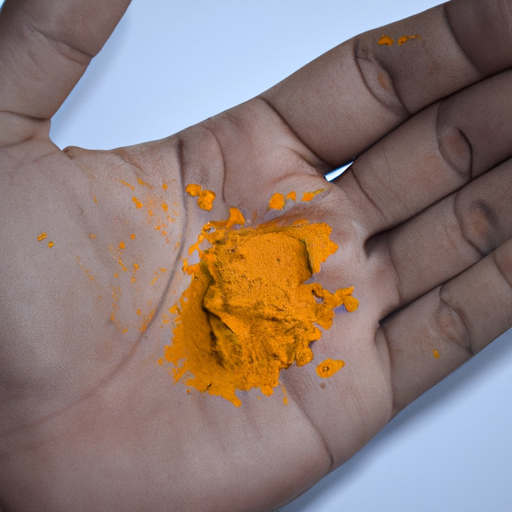I have always been intrigued by the therapeutic abilities of nature. Whether it be herbs or roots, there is a special quality to natural remedies that can improve our overall well-being and happiness.
One such ingredient that has caught my attention recently is turmeric root. This humble spice has been used in traditional medicine for centuries and now, it’s gaining popularity as a superfood due to its numerous health benefits.
And what better way to incorporate this powerful ingredient into our daily routine than making a warm cup of turmeric tea with the root? Making turmeric tea with the root is surprisingly easy and requires only a few ingredients that you might already have in your pantry.
In this article, I will guide you through each step of the process so you can enjoy a delicious cup of golden goodness anytime you want. Whether you’re looking for a natural remedy for inflammation or just craving a comforting drink, turmeric tea with the root is definitely worth trying out!
So let’s get started on this journey towards good health and wellness together!
Key Takeaways
- Turmeric root is a natural remedy with numerous health benefits, and making turmeric tea with the root is gaining popularity as a superfood.
- To prepare turmeric tea with the root, select and prepare the turmeric root by cutting it into thin slices or grating it, adding it to boiling water, and letting it simmer for about 15 minutes before straining it into a cup and adding sweetener of your choice.
- Adjusting the ingredients, brewing time, and straining the tea are key to making the perfect cup of turmeric tea, and adding ginger or cinnamon can enhance the flavor and provide additional health benefits.
- Turmeric tea has numerous health benefits such as reducing inflammation, boosting immunity, improving digestion, and promoting healthy skin, but individuals should consider safety and side effects, dosage, and frequency before incorporating it into their routine and consult with a healthcare professional before starting a regular turmeric tea regimen.
Selecting and Preparing the Turmeric Root
First, you’ll need to choose a fresh turmeric root from the grocery store and wash it thoroughly under cold running water, feeling the firmness of the root in your hand as you do so. The size of the root matters too; choose one that is about two inches long and an inch thick for a single cup of tea.
Once clean, use a vegetable peeler or paring knife to remove the skin from the root. Be careful not to cut yourself or waste any of the precious flesh.
After cleaning and peeling, cut the turmeric root into thin slices using a sharp knife or mandoline slicer. You can also grate it if you prefer smaller pieces.
Now that your turmeric is ready, we can move on to preparing the tea by boiling it with other ingredients such as ginger and honey.
Preparing the Tea
Now that you’ve got your ingredients ready, it’s time to start brewing this warm and cozy beverage. To prepare turmeric tea with the root, follow these simple steps:
- Bring water to a boil in a pot or kettle.
- Add thinly sliced turmeric root to the boiling water and let it simmer for about 15 minutes.
Once the tea is done, strain it into a cup and add any sweetener of your choice. Not only does turmeric tea taste great, but it also has numerous health benefits such as reducing inflammation, boosting immunity, improving digestion, and promoting healthy skin.
If you’re looking for different ways to sweeten your turmeric tea without using refined sugar or artificial sweeteners, try adding honey, maple syrup, or stevia for a natural touch of sweetness.
To add flavor to your tea, consider adding other spices like ginger or cinnamon. These spices not only enhance the flavor profile but also provide additional health benefits. So go ahead and experiment with different flavors until you find the perfect combination that suits your taste buds!
Adding Flavor to Your Tea
To enhance the taste of your turmeric tea, consider spicing it up with ginger or cinnamon. These spices not only add flavor but also provide additional health benefits. Ginger has been shown to improve digestion and reduce nausea, while cinnamon can improve brain function and even help control blood sugar levels in people with type 2 diabetes.
Here’s a table that summarizes some of the health benefits of adding these spices to your turmeric tea:
| Spice | Health Benefits |
|---|---|
| Ginger | Improves digestion, reduces nausea |
| Cinnamon | Improves brain function, helps control blood sugar levels |
By adding these spices to your turmeric tea, you not only get a delicious and flavorful drink but also reap the added health benefits. Now that we’ve talked about how to add flavor to your tea, let’s move on to some tips for making the perfect cup of turmeric tea.
Tips for Making the Perfect Cup of Turmeric Tea
When it comes to making the perfect cup of turmeric tea, I’ve found that adjusting the ingredients, brewing time, and straining the tea are key.
By experimenting with different amounts of turmeric, ginger, and honey, you can customize your tea to suit your tastes.
It’s also important to brew the tea for just the right amount of time to bring out all the flavors and health benefits.
And finally, straining your tea properly ensures a smooth and enjoyable drinking experience.
Adjusting the Ingredients
If you’re looking to add some extra flavor and health benefits to your turmeric tea, consider adjusting the ingredients. There are many different varieties of turmeric available, each with its unique flavor profile and medicinal properties.
For example, black turmeric has a slightly bitter taste and is known for its powerful anti-inflammatory effects, while yellow turmeric is more commonly used in cooking and has a milder flavor. You can also experiment with other ingredients like ginger or cinnamon to enhance the flavor of your tea and boost its health benefits even further.
Ginger is especially beneficial for digestion, while cinnamon can help regulate blood sugar levels. By adjusting the ingredients in your turmeric tea recipe, you can create a personalized blend that suits your taste preferences and supports your overall well-being.
Now let’s move on to the next section about brewing time – this is an essential step in ensuring that you get the most out of your cup of turmeric tea.
Brewing Time
As you let the warm water and turmeric blend simmer, the longer you allow it to steep, the more potent your immune-boosting elixir will be. However, the brewing time doesn’t only affect the strength of your tea but also its flavor.
If you prefer a milder taste, 5-10 minutes should suffice, while steeping for 20-30 minutes will yield a bolder flavor and color. But there are benefits beyond brewing time when it comes to turmeric tea.
For instance, adding ginger or black pepper can enhance its anti-inflammatory properties or improve digestion. You can also sweeten it with honey or add lemon juice for extra Vitamin C. Experimentation is key in finding what variations suit your tastes and needs best.
Now that your tea has brewed long enough, let’s move on to straining it for optimal enjoyment!
Straining the Tea
Now that our turmeric tea has brewed for the appropriate amount of time, it’s time to move on to the next step: straining the tea. This is an important step in ensuring a smooth and enjoyable cup of tea, as well as removing any leftover bits of ginger or turmeric root.
When it comes to straining techniques, there are several options available. Personally, I prefer using a fine mesh strainer or cheesecloth to remove any remaining solids from the tea. This ensures that only the flavorful and beneficial liquid remains in my cup. Not only does this enhance the taste and texture of my turmeric tea, but it also maximizes its health benefits by eliminating any unwanted particles from my drink.
Serving and Enjoying Turmeric Tea
To savor your turmeric tea, I recommend adding a splash of honey or a squeeze of lemon for extra flavor. Not only do these ingredients enhance the taste, but they also offer additional health benefits. Honey’s antibacterial properties can soothe sore throats, while lemon’s vitamin C can aid digestion.
It’s worth noting that while turmeric has many health benefits, there are possible side effects if consumed in excess. If you experience any negative reactions, such as stomach discomfort or headaches, it may be best to reduce your intake or consult with a healthcare professional.
Additionally, there are many variations and recipes for turmeric tea that you can explore to find the perfect blend for your taste buds.
As we move onto the next section about storing turmeric tea, keep in mind that freshly brewed tea is always best. But if you have leftover tea, let it cool before transferring it to an airtight container and storing it in the fridge for up to 3 days.
Storing Turmeric Tea
When it comes to storing turmeric tea, there are a few key points to keep in mind.
Firstly, if you have leftover tea, it’s best to refrigerate or freeze it for later use.
Secondly, when reheating the tea, be sure not to boil it as this can diminish its health benefits.
Lastly, while the shelf life of turmeric tea depends on various factors such as storage conditions and ingredients used, generally speaking, it’s best consumed within a few days of preparation for optimal freshness and flavor.
Refrigeration and Freezing
If you’re worried about your fresh turmeric root going bad, don’t fret – simply store it in the refrigerator or freezer for extended use. Turmeric root benefits are plenty and cooking with turmeric root is a great way to incorporate this spice into your daily diet.
When stored properly, fresh turmeric can last up to 2 weeks in the refrigerator and up to 6 months in the freezer. To refrigerate your turmeric root, wrap it in paper towels or place it in an airtight container. Keep it towards the back of your fridge where temperatures are more consistent.
If you want to freeze your turmeric root, peel and slice it into small pieces before placing them in an airtight bag or container. Make sure to label and date the container so you know how long it’s been frozen for.
Now that you know how to properly store fresh turmeric root, let’s move on to reheating the tea.
Reheating the Tea
Fortunately, reheating your turmeric-infused beverage is quick and easy. There are several methods you can use to reheat your tea, depending on your preference. One of the easiest ways is to simply microwave it for 30 seconds or until it reaches your desired temperature.
Alternatively, you can reheat it on the stove by pouring it into a small saucepan and warming it over low heat. While some people may think that reheating tea will diminish its health benefits, that’s not necessarily true.
In fact, certain studies have shown that reheating tea can actually increase the concentration of certain antioxidants and polyphenols found in the drink. So not only does reheating your turmeric tea make it more convenient to drink throughout the day, but it may also provide additional health benefits as well.
Now let’s move on to discussing how long you can expect your turmeric tea to last before going bad.
Shelf Life
Did you know that the shelf life of your turmeric-infused beverage is longer than you might think, and it may surprise you? Turmeric tea benefits are numerous, including its anti-inflammatory properties and ability to boost immunity.
However, many people worry about how long they can store their homemade turmeric tea before it goes bad. The good news is that when properly stored in an airtight container in the fridge, your turmeric tea can last up to a week.
Turmeric tea recipes come in many variations, but regardless of which one you choose, make sure to use fresh ingredients for maximum health benefits and taste. If you notice any changes in color or smell, it’s best to discard the tea as it may have gone bad.
Now that we’ve covered the shelf life of turmeric tea let’s move onto other uses for turmeric.
Other Uses for Turmeric
I want to talk about the other uses for turmeric. Before diving into it, it’s important to consider safety and side effects, dosage, and frequency, as well as benefits and risks.
As someone who believes in a holistic and plant-based lifestyle, I always make sure to educate myself on these aspects before incorporating any new herb or spice into my routine.
Safety and Side Effects
Although turmeric is generally safe, it’s important to be aware of its potential side effects when consuming the root in tea form. Allergic reactions are possible, especially for those who are allergic to ginger or other members of the Zingiberaceae family. Symptoms may include rash, itching, and difficulty breathing.
It’s also important to note that turmeric can interact with certain medications such as blood thinners or diabetes medications. To avoid any potential negative effects, it’s best to consult with a healthcare professional before starting a regular turmeric tea regimen. They can help determine if there are any potential interactions with medications and advise on an appropriate dosage and frequency.
With proper care and attention, enjoying turmeric tea can be a beneficial addition to one’s wellness routine.
Dosage and Frequency
When incorporating turmeric into your routine, it’s important to establish a consistent dosage and frequency that works best for you. Here are some tips to help guide you in finding the right balance:
- Start small: Begin with 1/4 to 1/2 teaspoon of turmeric per day and gradually increase as needed.
- Be consistent: Take turmeric daily, either through food or supplements, for maximum benefits.
- Consider your health needs: If you’re using turmeric tea as a natural remedy for a specific condition, consult with a healthcare professional to determine the proper dosage.
- Listen to your body: Pay attention to how you feel after consuming turmeric tea and adjust the dosage accordingly.
By following these guidelines, you can reap the many turmeric tea benefits while avoiding any potential risks associated with overconsumption.
In the next section, we’ll explore these benefits and risks in more detail.
Benefits and Risks
To fully understand the potential benefits and risks of incorporating turmeric into your routine, it’s important to explore both sides in detail.
Turmeric has been hailed for its anti-inflammatory and antioxidant properties, which can help improve digestion, reduce inflammation and support healthy brain function. It also contains curcumin, a compound that has been found to have anticancer effects.
However, it’s important to note that there are some potential contraindications when consuming turmeric. For example, high doses of turmeric may cause digestive issues such as bloating or diarrhea. Additionally, individuals with gallbladder problems or those taking certain medications should consult their healthcare provider before incorporating turmeric supplements into their routine.
As with any supplement or herb, it’s always best to approach with caution and talk to a healthcare provider before starting a new regimen.
Frequently Asked Questions
Can turmeric tea be consumed cold?
Yes, I love to enjoy turmeric tea cold! It’s a refreshing way to reap the health benefits of this powerful root. Turmeric is anti-inflammatory and antioxidant-rich, making it great for supporting overall wellness.
How often can turmeric tea be consumed?
I enjoy drinking turmeric tea for its health benefits. It’s recommended to consume 1-2 cups daily, but it’s important to listen to your body and not overdo it. As with any natural remedy, moderation is key.
Can turmeric tea be made with powdered turmeric instead of root?
Just as a flower needs its roots to bloom, fresh turmeric root is essential for the full benefits of turmeric tea. While powdered turmeric tea can be made, nothing compares to the natural potency and flavor of using fresh turmeric.
Can honey be used as a sweetener in turmeric tea?
I love adding honey as a natural sweetener to my turmeric tea. It not only enhances the taste but also offers numerous health benefits. Adding ginger to the mix also boosts its anti-inflammatory and antioxidant properties.
Can turmeric tea help with weight loss?
While turmeric tea alone won’t lead to significant weight loss, studies suggest it can boost metabolism and aid in digestion. Incorporating it into a healthy diet and exercise routine may provide benefits for those looking to shed pounds naturally.
Conclusion
Making turmeric tea with the root is a simple and enjoyable way to incorporate this powerful spice into your daily routine. As I sip on my warm cup of turmeric tea, I can feel its healing properties flowing through my body.
The earthy aroma and vibrant yellow color remind me of the sun-kissed fields where this magical root grows. As I take another sip, I am transported to a world where nature provides everything we need for our health and well-being.
Turmeric tea is not just a beverage, it’s a reminder that we are connected to the earth and all its wonders. So next time you feel like indulging in something warm and soothing, reach for some fresh turmeric root and make yourself a cup of this golden elixir. Your body will thank you!










